 |
 |
 |
 |
 |
 |
 |
 |
 |
 |
 |
 |
 |
 |
 |
 |
 |
 |
 |
 |
 |
 |
 |
 |
 |
 |
 |
 |
 |
 |
 |
 |
 |
 |
 |
 |
 |
 |
 |
 |
 |
 |
 |
 |
 |
 |
 |
 |
 |
 |
 |
 |
 |
 |
 |
 |
 |
 |
|
|
|
|
|
|
|
|
|
|
|
|
|
|
|
|
|
|
|
|
|
|
|
|
|
|
|
|
|
|
|
|
|
|
|
|
|
|
|
|
|
|
|
|
|
|
|
|
|
|
|
|
|
|
|
|
|
|
|
|
 |
|
|
|
|
|

|
|
|
|
|
|

|
|

|
|

|
|
|
|
|
|
|
|
|
|
When one thinks of Brazil (spelled "Brasil" in Portuguese), they may think of the rain forest, the Carnival, the beaches and of course the beautiful people! However, when I embarked on my first journey to South America, I had quite a different purpose. I wanted to absorb as much of the culture as I could and be as close to the common people as I could. Of course, I came bearing gifts. My six-day sojourn with my university (Florida A&M) was interesting to say the least.
We visited São Paulo, the 3rd largest city on the planet. One does not get an idea of how large the city is until ascending to the top floor of the BANESPA building, the tallest in the city. It is from this point that the viewer can see the city in all of its magnificence. Here is a panoramic view I crudely stitched together from a few photos. The city has a lot in common with my birth city of Chicago, but had quite a unique culture. Viswanathan Anand recently won a tournament here, so I knew there was chess life here. However, I was not able to find it.
|
|
|
|
|
|
|
|
|
|
 |
|
|
|
|
São Paulo is the world's 3rd largest city.
|
|
|
|
|
 |
|
|
|
|
|
|
|
|
|
|
It all started on March 5th when a group from my university set out for Brazil on a Saturday morning during Spring Break. We were originally scheduled to visit Salvador Bahia, but the organizer could not manage affordable accommodations. Personally, I was disappointed because I was anxious to see authentic "capoeira," the martial art brought from Africa by Angolan slaves.
Salvador Bahia is also the place where the Quilombos were organized in the 17th century to fight against the Dutch and Portuguese slave traders. The slaves disguised this deadly art form as dancing and gymnastics. Slavery was abolished in 1888, but Afro-Brazilians are still fighting for recognition; thus, the "Black Power" movement is flourishing.
|
|
|
|
|
|
|
|
|
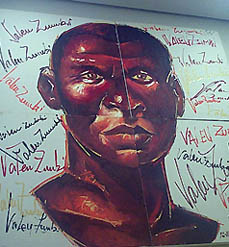
|
|
|
|
|
|
|
|
|
|
In São Paulo, we visited the historically-Black Universidade Zumbi dos Palmares… the only one of its kind in South America. This university was named after Zumbi (above), a revolutionary martyr who led the struggle against the invaders of the quilombos (African communities). The Afro-Brazilians are very much alive and were eager to show us that they appreciated our kinship. Much of this history was recounted upon our visit to the fascinating "museu afro-brasil" or Afro-Brazilian museum.
|
|
|
|
|
|
|
|
|
|
 |
|
|
|
|
With a population of about 175 million, Brazil is known for its carnival, its rainforest, its football prowess and for its beautiful women. In chess, Brazil has six Grandmasters with the top player being Giovanni Vescovi who has a FIDE rating of 2645.
|
|
|
|
|
 |
|
|
|
|
|
|
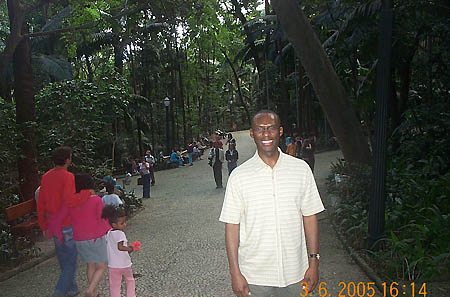
|
|

|
|

|
|
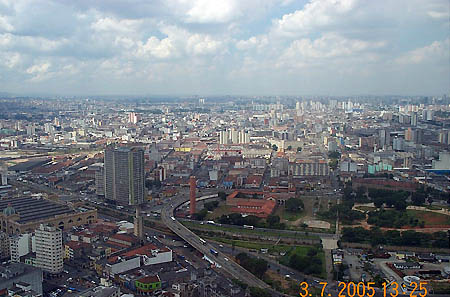
|
|
|
|
|
|
|
|
|
|
View of São Paulo
from hotel's top floor
|
|
|
|
|
|
|
|
|
|
|
|
Daaim Shabazz
in Parque da Luz
|
|
|
|
|
|
|
|
|
|
McDonald's...
of course, I didn't eat here.
|
|
|
|
|
|
|
|
|
|
|
|
|

|
|
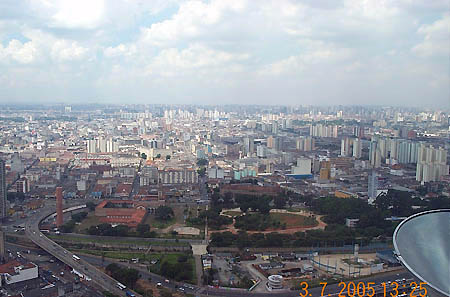
|
|
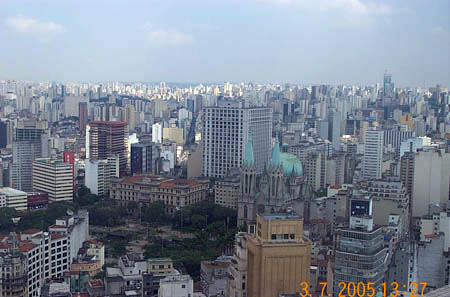
|
|
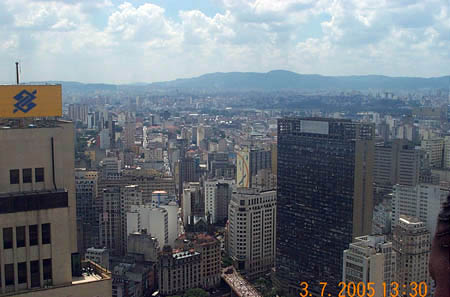
|
|
|
|
|
|
|
|
|
|
Nice Brazilian family
on a downtown stroll
|
|
|
|
|
|
|
|
|
|
Aerial shots from the BANESPA building
|
|
|
|
|
|
|
|
|
|
3rd largest city
in the world!
|
|
|
|
|
|
|
|
|
|
Mountains
in the background
|
|
|
|
|
|
|
|
|
|
|
|
|
|
|
|
|
|
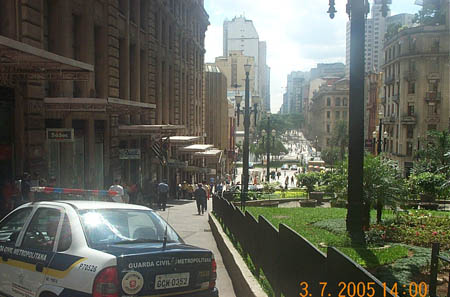
|
|
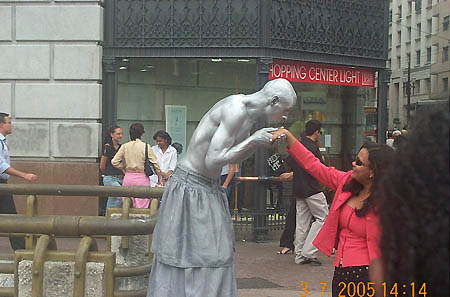
|
|
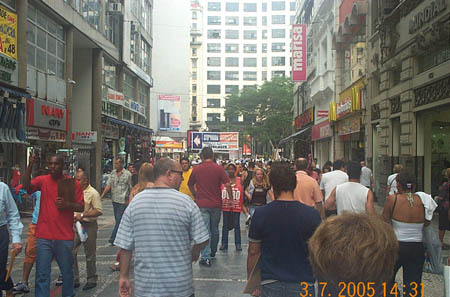
|
|
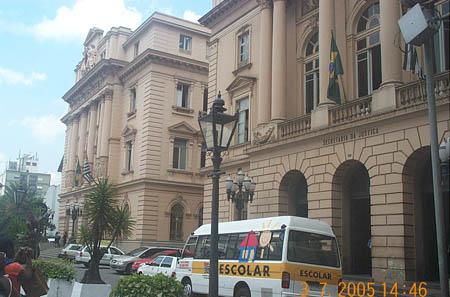
|
|
|
|
|
|
|
|
|
|
|
|
|
|
|
|
|
|
|
|
|
|
|
|
|
|
|

|
|
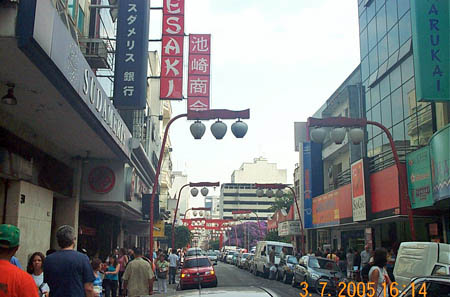
|
|
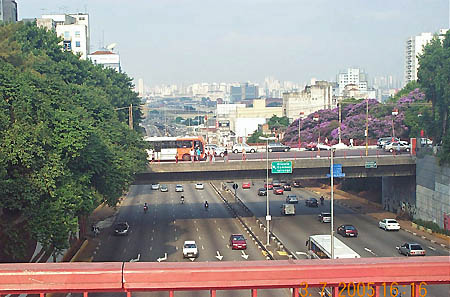
|
|
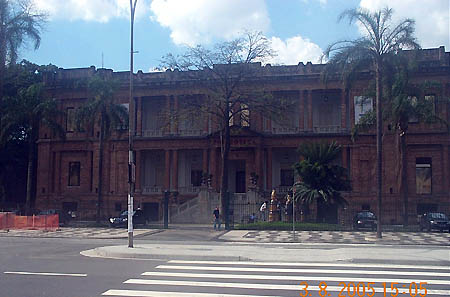
|
|
|
|
|
|
|
|
|
|
Nice view of court
in downtown area
|
|
|
|
|
|
|
|
|
|
Liberdade
(Japanese community)
|
|
|
|
|
|
|
|
|
|
|
|
|
|
|
|
|
|
|
|
|
|
|
|
|
|
Visit to the Favelas
In the latter part of the trip, we visited one of the favelas (impoverished communities) which ironically sits across the highway from the majestic buildings of billion-dollar corporations. These communities were built when migrants from Bahia (and elsewhere) were unable to find housing. As it is in many poor countries, the people appear to be in high spirits and possess pride despite their meager existence. The children were full of life and absolutely adorable. I donated a chess set, instructions and 50 Chess Drum pens to the Centro Communitário Ludovico Pavoni community center in the favela. Who knows what may come of it? One can only plant the seeds and hope that they somehow take root.
|
|
|
|
|
|
|
|
|
|
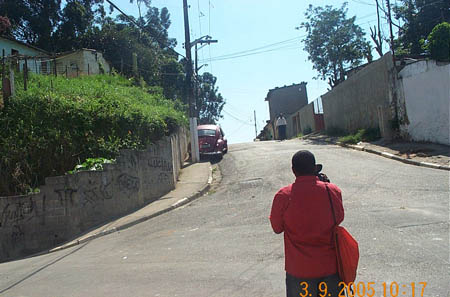
|
|
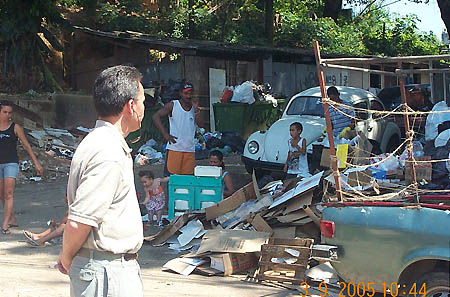
|
|
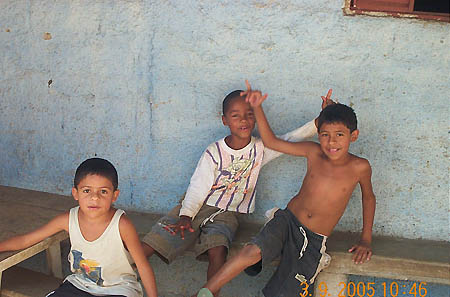
|
|
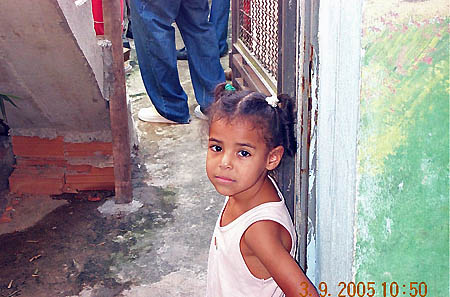
|
|
|
|
|
|
|
|
|
|
|
|
|
Exuberance
of innocent boys and…
|
|
|
|
|
|
|
|
|
|
|
|
|
|
|
|
|
|
|
|
|
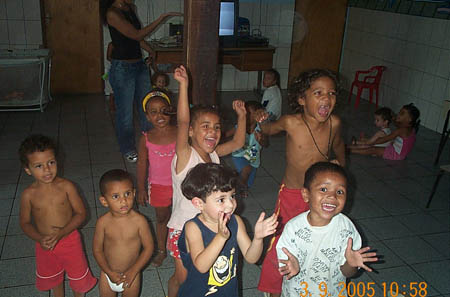
|
|
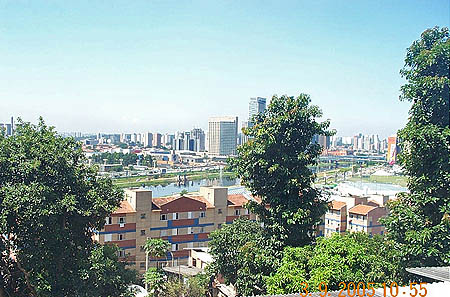
|
|
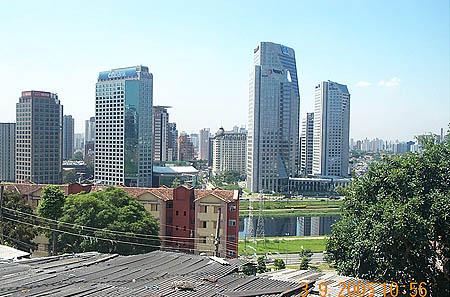
|
|
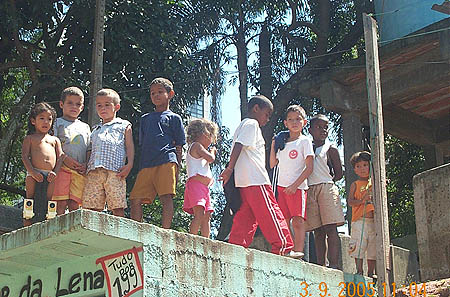
|
|
|
|
|
|
|
|
Children cheering each flash of camera
|
|
|
|
|
|
|
|
|
|
Singapura housing
(lower half of picture).
|
|
|
|
|
|
|
|
|
|
Strange irony …
view of rich by the poor.
|
|
|
|
|
|
|
|
|
|
What must these children
be thinking?
|
|
|
|
|
|
|
|
|
|
|
|
|
|
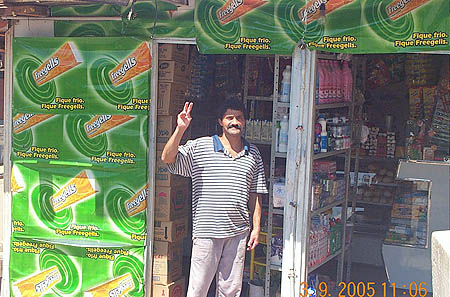
|
|
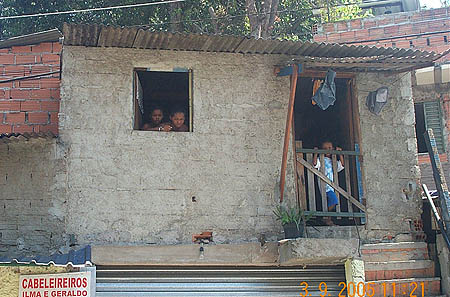
|
|

|
|

|
|
|
|
|
|
|
|
|
|
|
|
|
|
|
|
|
|
|
|
|
|
|
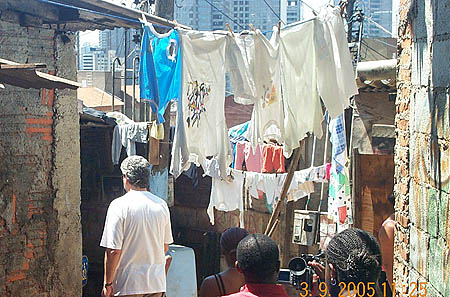
|
|
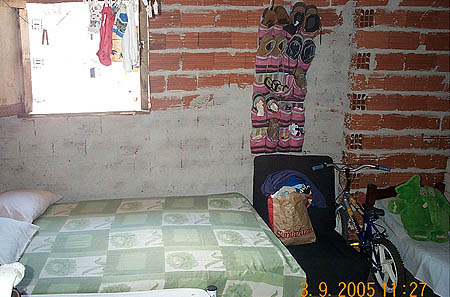
|
|
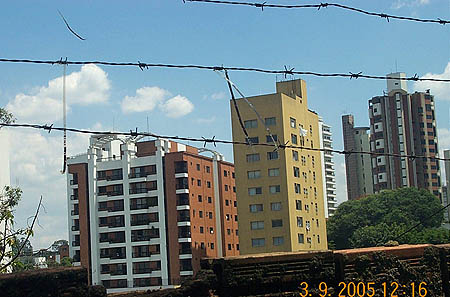
|
|
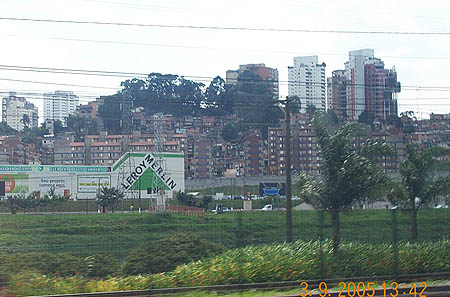
|
|
|
|
|
|
|
|
|
...living a simple life...
|
|
|
|
|
|
|
|
|
|
… yet, they maintain
self-pride! This place was immaculate.
|
|
|
|
|
|
|
|
|
|
Another view from inside the favelas...
|
|
|
|
|
|
|
|
|
|
…and a view
from the outside
|
|
|
|
|
|
|
|
|
|
|
|
|
|
|
|
|
|
|
|
|
|
|
|
Capoeira Demonstration
When the Portuguese brought the African slaves to Brazil to work in the coffee plantations, they brought many of the spiritual and cultural aspects with them. One of these art forms was capoeira. We were given a demonstration by a group while at the Universidade Zumbi dos Palmares and it was awe-inspiring. The chess-like moves of this art focus more on avoidance than with strikes and blocks… the balletic movements are a thing of beauty to watch. Of course, a few of members of the group were asked to join in the impromptu dance and I was one of them. The performers and audience seemed to appreciate my headstand and spinning kick (armada). One performer graciously commented that I had a future in capoeira!
|
|
|
|
|
|
|
|
|
|
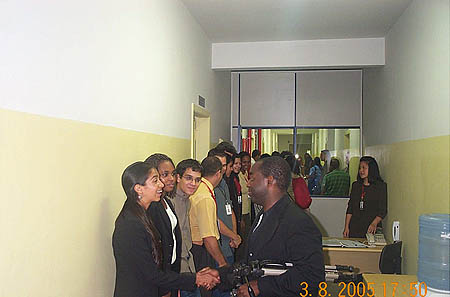
|
|
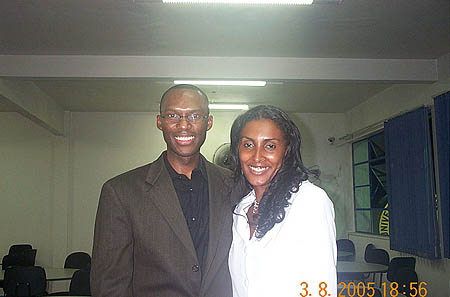
|
|
|
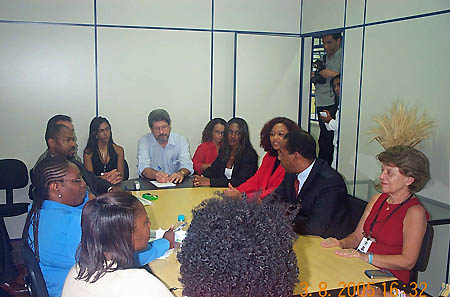
|
|
|
|
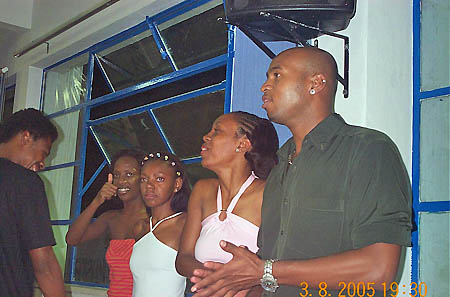
|
|
|
|
|
|
|
|
|
|
|
|
|
Meeting the
university students
|
|
|
|
|
|
|
|
|
|
Daaim Shabazz
poses with
TV1 reporter, Viviane.
|
|
|
|
|
|
|
|
|
|
|
Discussion at
Universidade Zumbi dos Palmares
|
|
|
|
|
|
|
|
|
|
|
|
Students preparing for samba demonstration
|
|
|
|
|
|
|
|
|
|
|
|
|
|
|
|
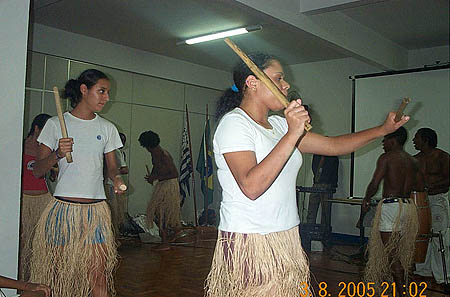
|
|
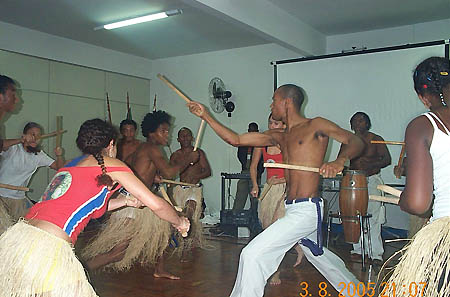
|
|
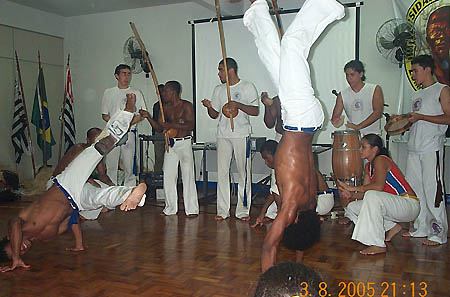
|
|
|
|
|
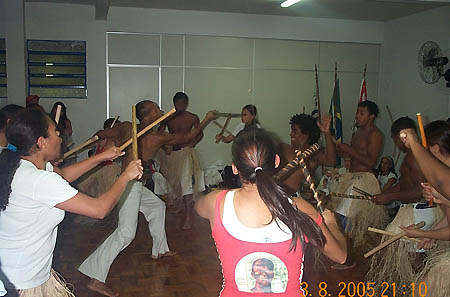
|
|
|
|
|
|
|
|
|
|
|
|
|
|
|
Bamboo
stick-fighting (maculelê)
|
|
|
|
|
|
|
|
|
|
Those were real blades.
Sparks were flying!
|
|
|
|
|
|
|
|
|
|
You think break-dancing
started in America?
|
|
|
|
|
|
|
|
|
|
|
|
|
|
|
|
|
|
|
|
|
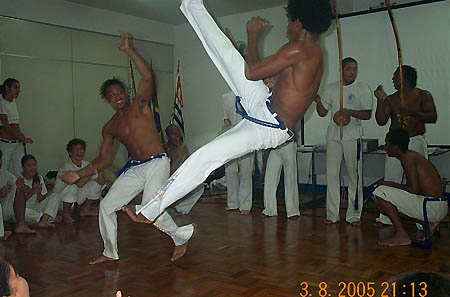
|
|
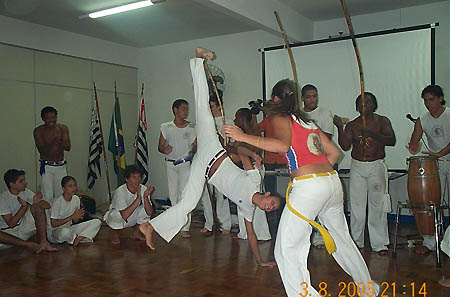
|
|
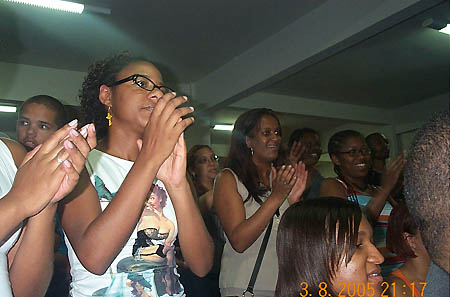
|
|
|
|
|
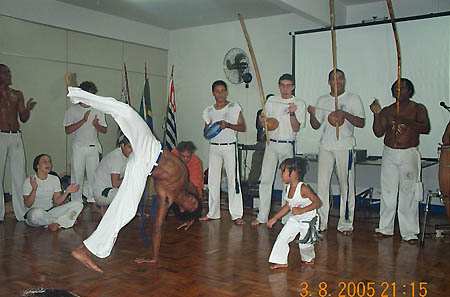
|
|
|
|
|
|
|
|
|
|
|
|
|
|
|
|
|
Young capoeirista accepts the challenge.
|
|
|
|
|
|
|
|
|
|
The Brazilian audience
loves it!
|
|
|
|
|
|
|
|
|
|
|
|
|
|
|
|
|
|
|
|

|
|
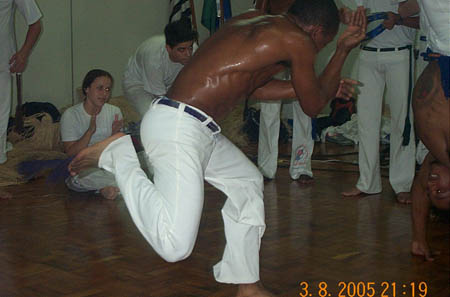
|
|

|
|
|
|
|
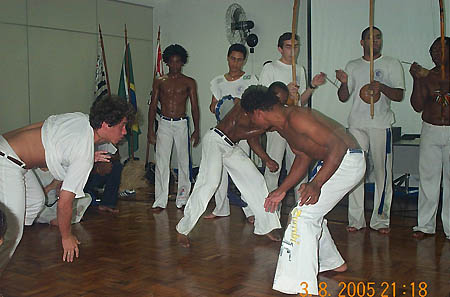
|
|
|
|
|
|
|
|
|
|
|
|
|
The cute little capoeirista.
|
|
|
|
|
|
|
|
|
|
|
|
|
|
Zumbi students leaving
10:00pm class.
|
|
|
|
|
|
|
|
|
|
|
|
|
|
|
|
|
Xadrez Brasil?
While in Brazil, David Allen e-mailed me about Afro-Brazilian players. From a chess standpoint, I didn't find much in Afro-Brazilian history, but I did get a few leads. In fact, we visited the Raça (pronounced ha-sa) magazine which caters to Afro-Brazilian life and culture and they may run a "Chess Drum" special… in Portuguese of course. Conceição Lourenço, the "Directora de Radação" of Raça, possesses an effervescent personality and seemed to enjoy our group discussion about issues in the Black Diaspora.
I only met one Afro-Brazilian who played chess ("xadrez" pronounced "sha-drez"). He was primarily a disk jockey who worked at company that publishes Raça. I gave him a tour of The Chess Drum after which he mentioned his father who runs an Afro-Brazilian website (www.portalafro.com.br). He also stated that his sister used to compete for Brazil years ago, but no longer plays. Hopefully, I will find out more about her or about any Afro-Brazilian players. One member of my tour group stated that he saw two players playing blitz on the beach in Sao Paulo. Shame on me!
|
|
|
|
|
|
|
|
|
|
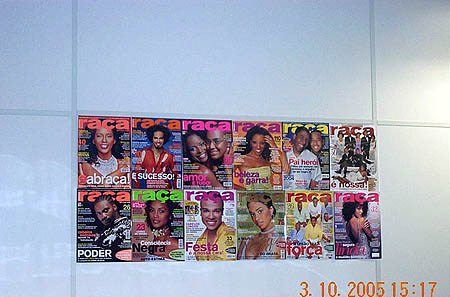
|
|
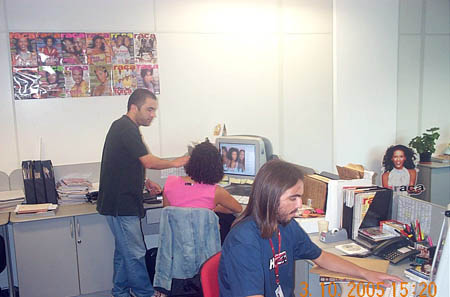
|
|
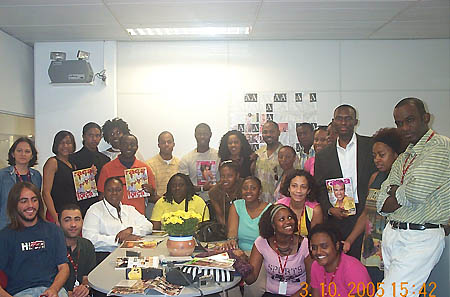
|
|

|
|
|
|
|
|
|
|
|
|
|
|
Laying out
a top-notch magazine.
|
|
|
|
|
|
|
|
|
|
Florida A&M University
with Raça staff.
|
|
|
|
|
|
|
|
|
|
|
|
|
|
|
Daaim Shabazz with
Conceição Lourenço,
editor of Raça magazine.
|
|
|
|
|
|
|
|
|
|
|
|
|
|
|
|
|
|
|
|
|
|
|
|
|
|
Final Thoughts
Foreign travel is certainly an eye-opening experience and it is important that people of African descent see each other and learn of the commonalities that we all share. Of course, the differences cannot be denied, but there is something to be said about our common struggles which cause us to have a deep appreciation for who and what we are. Language barriers have served to divide us, but there are certain forms of communications that are as clear as the spoken voice or the written word. This spirit is as evident in Brazil as it is on the African continent itself!
Note: Sincere thanks to Caio Cardoso and Thalita Stein for serving as wonderful hosts and making this trip memorable.
Composed and Written: 25 March 2005
|
|
|
|
|
|
|
|
|
|
|
|
|
|
|
|
 |
|
 |
|
|
|
|
|
|
|
|
|
|
|
|
|
|
|
|
|
|
|
|
|
|
|
|
|
 |
|